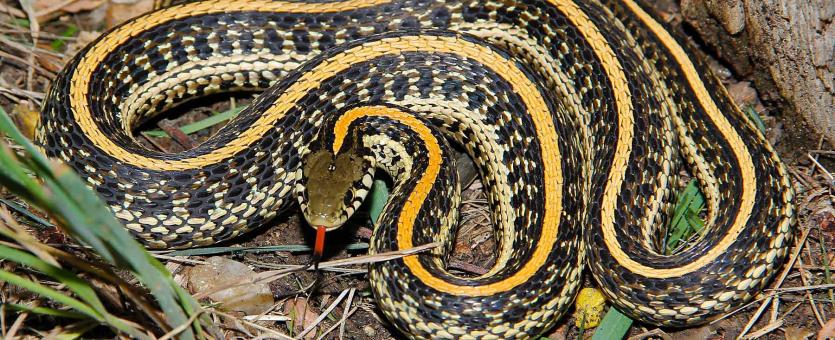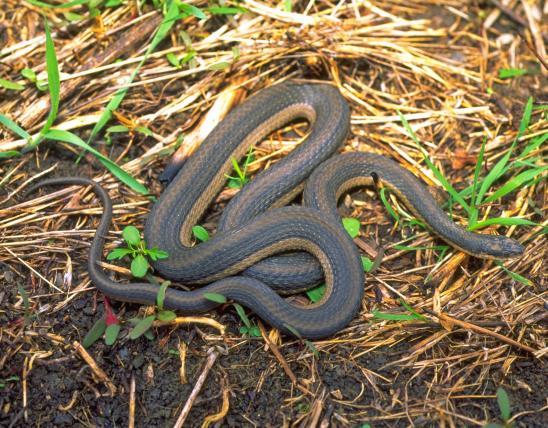
The plains gartersnake is a medium-sized, striped snake of wet prairies and marshes. One of Missouri's three species of gartersnakes, its ground color is greenish gray, olive, or brown, but some individuals can be very dark. The stripe along the middle of the back is bright yellow, orange, or orangish yellow. Another light stripe, which may be yellow, green, or blue, runs along on each side. The area between light stripes usually has an alternating double row of black spots. The light-green upper lip has boldly marked black bars along the edges of the scales. The belly is gray or greenish gray, with a row of black spots along each side.
Like other gartersnakes, when captured or molested, this snake will smear a musky secretion from glands at the base of the tail.
Similar species: Missouri has two other gartersnakes: the eastern and red-sided gartersnakes (both subspecies of the common gartersnake, Thamnophis sirtalis) and the orange-striped ribbonsnake (Thamnophis proximus proximus). The markings (or lack of markings) on the upper jaw scales (supralabial scales) are key characters:
- The eastern and red-sided gartersnakes have narrow black bars (not boldly marked black bars) along the upper jaw.
- The orange-striped ribbonsnake has unmarked scales along the upper jaw: they are plain white or pale green, lacking black bars, and the light coloration of this "upper lip" contrasts against the ribbonsnake's dark head.
Adult length: 15 to 28 inches; occasionally to 43 inches.

Occurs mainly in Missouri's north-central and northwestern counties, with isolated populations in and west of the St. Louis area
Habitat and Conservation
In Missouri, the plains gartersnake is usually active from late March to late October and occurs in wet prairies, meadows, marshes, lakes, ponds, and streams. They are especially associated with grassland habitat with abundant crayfish burrows close to water that harbors a variety of aquatic prey species.
On warm, sunny days, this species basks and searches for prey. Plains gartersnakes take shelter under logs, boards, rocks, or other objects.
The plains gartersnake spends winters underground, in abandoned rodent tunnels, anthills, and crayfish burrows.
Food
This gartersnake eats small frogs and their tadpoles, salamanders, earthworms, small fish such as minnows and mosquitofish, and on occasion small rodents.
Status
This species may have declined in Missouri with the significant loss of wet prairie habitat throughout northern Missouri. In the remaining wet prairie habitat, this species appears to be relatively secure.
The plains gartersnake used to be separated into two subspecies, the eastern plains gartersnake (T. r. radix) and western plains gartersnake (T. r. haydeni). Scientists no longer recognize these subspecies, so they are now lumped together as "plains gartersnake" (T. radix).
Life Cycle
Courtship and mating occur in April and May, soon after the snakes emerge from their overwintering sites, and sometimes also in autumn. Young are born from late July through early September, with 5–60 or more young per litter; 10–20 are the norm. Females become sexually mature after 2 or 3 years of life; males likely mature earlier. Lifespan can be 8 years or more.
Human Connections
This species may have declined due to the significant loss of wet prairie habitat as people converted native grasslands into agricultural fields. Protection and restoration of remnant, wet prairie habitat will ensure that the plains gartersnake remains on the Missouri landscape.
The plains gartersnake is an attractive species.
Fear and myth still surround snakes, due largely to a lack of knowledge about them. Fortunately, the biology and natural history of Missouri snakes are both interesting and enjoyable to learn. People who understand snakes tolerate and appreciate them as a natural part of outdoor Missouri.
Ecosystem Connections
As predators, gartersnakes help keep populations of other animals in check. Although they can defend themselves by trying to bite and by smearing foul-smelling musk on attackers, they and their young provide food for many predators.































